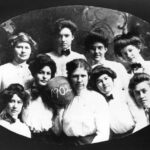Great Ideas on Energy: Energy Polls, Nanopartical Brooms, Campus Conservation
A century ago, The University of Texas was built on energy. Some sources may have changed, but as these brilliant innovations prove, UT is still charging ahead.
20. Track public opinion about energy issues in real time.
Energy solutions require more than technologies. What people really think about energy is critical. So in 2011, the McCombs School of Business launched the UT Energy Poll.
The poll tracks attitudes on topics from consumption and pricing to development and regulation. It uses Census Bureau figures so that data reflects the population.
A few notable findings so far: While fracking has been making headlines, just 32 percent of Americans say they have heard of the process. In March 2011, 65 percent of Americans said they thought climate change was occurring. By July’s heat wave, that number was 70 percent.
The poll will observe how sentiment shifts over time, because attitudes are shaped by more than “the facts.” People also take into account media, politicians, religious leaders, and friends. These perspectives influence the policies that shape the future. —Sheril Kirshenbaum
21. Use nanoparticles to find oil.
One hundred nineteen billion barrels. That’s one estimate of how much oil could be recoverable from American oilfields—including some judged no longer worth pumping. That’s because the more oil you pump out of a reservoir, the harder it becomes to get what’s left.
Now professors Steven Bryant and Keith Johnston have devised nanoparticles of silica and iron oxide that can be mixed into that fluid. These tiny particles could help us tap into that 119 billion barrels—and tuck greenhouse gases underground in the process.
After fluids are injected into an oil well, they flow back out to production wells, bringing oil up. That’s called sweeping the reservoir. Carbon dioxide is a popular “broom” because it’s a great solvent for underground oil.
The trouble is that under typical temperatures and pressures of oil reservoirs, CO2 is buoyant and runny, so it can find shortcuts back up rather than herding oil up through the reservoir’s porous rocks while remaining underground.
Engineers can make the CO2 better able to push oil up by mixing it with brine and surfactants to form a stiff foam. The downside is that these foams are quick to separate into their component liquids.
That’s where Bryant and Johnston’s nanoparticles come in. The tiny particles attach to CO2 bubbles, preventing them from coalescing. “Once you get [the nanoparticles] there, it’s difficult to knock them off,” Bryant says. “You get this inherent stability.” As a bonus, the stabilized foam is likelier to stay put underground, taking atmospheric CO2 out of circulation.
Bryant says the nanoparticles are ready for field-testing, and companies are interested. Meanwhile, oil is waiting for a better broom. —Jenny Blair
22. Task experts with conserving energy on campus.
With some 12 million square feet of building space, UT has massive real estate.
Many buildings are home to users who are passionate about the environment. But even they probably don’t know how to fully decipher a huge structure’s energy bill or which offices can make changes.
So Facilities Services hired four energy stewards to lead conservation on specific buildings. Each handles 2-3 million square feet.
First, the stewards conduct walk-through audits, explains Dan Costello, associate facilities maintenance director. Next they meet with building users to talk about how space is used. The stewards then make recommendations, like adjusting thermostats, reducing plug loads, and developing occupancy schedules.
It falls under the “UTakeCharge” initiative. “UTakeCharge enables clients to affect their environmental footprint,” Costello says.
The campus goal is to reduce energy consumption by 20 percent by 2020. That would save at least $4 million—paying for the stewards over and over again. -Lynn Freehill
Read all 22 great ideas on energy here.















No comments
Be the first one to leave a comment.